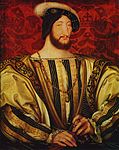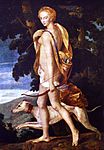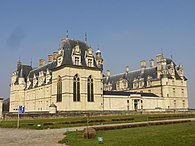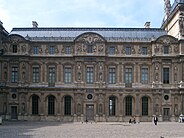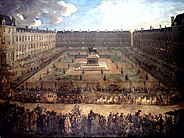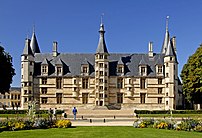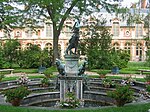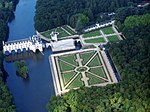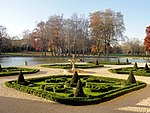French Renaissance
| Renaissance |
|---|
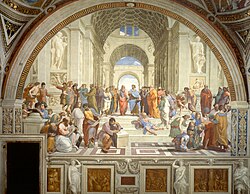 |
| Aspects |
| Regions |
| History and study |
TheFrench Renaissancewas theculturalandartistic movementinFrancebetween the 15th and early 17th centuries. The period is associated with the pan-European[1]Renaissance,a word first used by the French historianJules Micheletto define the artistic and cultural "rebirth" of Europe.
Notable developments during the French Renaissance include the spread ofhumanism,earlyexploration of the "New World"(asNew FrancebyGiovanni da VerrazzanoandJacques Cartier); the development of new techniques and artistic forms in the fields of printing,architecture,painting, sculpture, music, the sciences andliterature;and the elaboration of new codes of sociability, etiquette and discourse.
The French Renaissance traditionally extends from (roughly) the 1494French invasion of Italyduring the reign ofCharles VIIIuntil the 1610 death ofHenry IV,with an apex during the 1515–1559 reigns ofFrancis IandHenry II.
This chronology notwithstanding, certain artistic, technological or literary developments associated with the Renaissance arrived in France earlier (for example, by way of theBurgundycourt or thepapal court in Avignon); however, theBlack Deathof the 14th century and theHundred Years' Warkept France economically and politically weak until the late 15th century.
The word "Renaissance"
[edit]The wordRenaissanceis aFrenchword, whose literal translation into English is "Rebirth". The term was first used and defined[2]by French historianJules Micheletin his 1855 workHistoire de France(History of France).[1]Jules Michelet defined the 16th-century Renaissance in France as a period in Europe's cultural history that represented a break from the Middle Ages, creating a modern understanding of humanity and its place in the world.[3]As a French citizen and historian, Michelet also claimed the Renaissance as a French movement.[4]
Art
[edit]| French art history |
|---|
| Historical periods |
| French artists |
| Thematic |
| Movements |
| See also |
In the late 15th century, the Frenchinvasion of Italyand the proximity of the vibrantBurgundycourt (with itsFlemishconnections) brought the French into contact with the goods, paintings, and the creative spirit of theNorthernandItalian Renaissance,and the initial artistic changes in France were often carried out by Italian and Flemish artists, such asJean Clouetand his sonFrançois Clouetand the ItaliansRosso Fiorentino,Francesco PrimaticcioandNiccolò dell'Abbateof the firstSchool of Fontainebleau(from 1531).
In 1516,Francis I of FranceinvitedLeonardo da Vincito theChâteau d'Amboiseand provided him with theChâteau du Clos Lucé,then called Château de Cloux, as a place to stay and work.[5]Leonardo, a famous painter and inventor, arrived with three of his paintings, namely theMona Lisa,Sainte Anne,andSaint Jean Baptiste,today owned by theLouvre museumofParis.
The art of the period from Francis I throughHenry IVis often inspired by late Italian pictorial and sculptural developments commonly referred to asMannerism(associated withMichelangeloandParmigianino,among others), characterized by figures which are elongated and graceful and a reliance on visualrhetoric,including the elaborate use ofallegoryandmythology.
There are a number of French artists in this period including the painterJean Fouquetof Tours (who achieved realistic portraits and remarkableilluminated manuscripts) and the sculptorsJean GoujonandGermain Pilon.
Late Mannerism and early Baroque
Henry IV invited the artistsToussaint Dubreuil,Martin FréminetandAmbroise Duboisto work on thechâteau of Fontainebleauand they are typically called the secondSchool of Fontainebleau.
Marie de' Medici,Henry IV's queen, invited theFlemishpainterPeter Paul RubenstoFrance,and the artist painted a number of large-scale works for the queen'sLuxembourg Palacein Paris. Another Flemish artist working for the court wasFrans Pourbus the younger.
Outside France, working for the dukes ofLorraine,one finds a very different late mannerist style in the artistsJacques Bellange,Claude DeruetandJacques Callot.Having little contact with the French artists of the period, they developed a heightened, extreme, and often erotic mannerism (including night scenes and nightmare images), and excellent skill inetching.
-
Eve, First PandorabyJean Cousin the Elder(c. 1550).
-
Ligier Richier,Lamentation of Christ,Church of St. Étienne,Saint-Mihiel
-
Diane the Huntress,School of Fontainebleau(1550–60) (Louvre).
-
Monument containing the heart ofHenry II of FrancebyGermain Pilon.
-
Portrait of Gabrielle d'Estrées and Duchess of Villars,School of Fontainebleau,c. 1594
-
Allégorie de la Peinture et de la Sculpture,Ambroise Dubois
-
Hyacinthe and Climène at Their Morning Toilet(detail) byToussaint Dubreuil,a scene fromPierre de Ronsard'sFranciade(c. 1602) (Louvre)
Architecture
[edit]One of the greatest accomplishments of the French Renaissance was the construction of theChâteaux of the Loire Valley:no longer conceived of as fortresses, these pleasure palaces took advantage of the richness of the rivers and lands of theLoireregion and they show remarkable architectural skill.
The oldLouvrecastle inPariswas also rebuilt under the direction ofPierre Lescotand would become the core of a brand new Renaissancechâteau.To the west of the Louvre,Catherine de' Medicihad built for her theTuileriespalace with extensive gardens and agrotte.
The ascension ofHenry IV of Franceto the throne brought a period of massive urban development inParis,including construction on thePont Neuf,thePlace des Vosges(called the "Place Royale" ), thePlace Dauphine,and parts of theLouvre(amongst which the Great Gallery).
Garden
[edit]French Renaissance gardens were characterized by symmetrical and geometric planting beds orparterres;plants in pots; paths of gravel and sand; terraces; stairways and ramps; moving water in the form of canals,cascadesand monumental fountains, and extensive use of artificialgrottes,labyrinthsand statues of mythological figures. They became an extension of the chateaux that they surrounded, and were designed to illustrate the Renaissance ideals of measure and proportion.
-
Gardens of theChâteau de Villandry
-
Diane de Poitiers' garden from theChâteau de Chenonceau
-
Fountain of Diana, in the gardens of theChâteau de Fontainebleau
-
Aerial view ofChâteau de Chenonceauand its gardens
-
Jardin de la volière atChâteau de Chantilly
Literature
[edit]Music
[edit]
Burgundy,the mostlyFrench-speaking area unified with theKingdom of Francein 1477. Many of the most famous musicians in Europe either came from Burgundy, or went to study with composers there; in addition there was considerable interchange between the Burgundian court musical establishment and French courts and ecclesiastical organizations in the late 15th century. TheBurgundian stylegave birth to theFranco-Flemish styleofpolyphonywhich dominated European music in the late 15th and early 16th centuries. However, by the end of the 15th century, a French national character was becoming distinct in music of the French royal and aristocratic courts, as well as the major centers ofchurch music.For the most part French composers of the time shunned the sombre colors of the Franco-Flemish style and strove for clarity of line and structure, and, in secular music such as thechanson,lightness, singability, and popularity.Guillaume Du FayandGilles Binchoisare two notable examples from the Burgundian school during the early Renaissance period.
The most renowned composer in Europe,Josquin des Prez,worked for a time in the court ofLouis XII,and likely composed some of his most famous works there (his first setting of Psalm 129,De profundis,was probably written for the funeral of Louis XII in 1515). Francis I, who becamekingthat year, made the creation of an opulent musical establishment a priority. His musicians went with him on his travels, and he competed withHenry VIIIat theField of the Cloth of Goldin 1520 for the most magnificent musical entertainment; likely the event was directed byJean Mouton,one of the most famousmotetcomposers of the early 16th century after Josquin.
By far the most significant contribution of France to music in the Renaissance period was thechanson.The chanson was a variety of secular song, of highly varied character, and which included some of the most overwhelmingly popular music of the 16th century: indeed many chansons were sung all over Europe. The chanson in the early 16th century was characterised by adactylicopening (long, short-short) andcontrapuntalstyle which was later adopted by the Italiancanzona,the predecessor of thesonata.Typically chansons were for three or four voices, without instrumental accompaniment, but the most popular examples were inevitably made into instrumental versions as well. Famous composers of these "Parisian" chansons includedClaudin de SermisyandClément Janequin.Janequin'sLa guerre,written to celebrate the French victory atMarignanoin 1515, imitates the sounds of cannon, the cries of the wounded, and the trumpets signaling advance and retreat. A later development of the chanson was the style ofmusique mesurée,as exemplified in the work ofClaude Le Jeune:in this type of chanson, based on developments by the group of poets known as thePléiadeunderJean-Antoine de Baïf,the musical rhythm exactly matched the stress accents of the verse, in an attempt to capture some of the rhetorical effect of music in Ancient Greece (a coincident, and apparently unrelated movement in Italy at the same time was known as theFlorentine Camerata). Towards the end of the 16th century the chanson was gradually replaced by theair de cour,the most popular song type in France in the early 17th century.
The era of religious wars had a profound effect on music in France. Influenced byCalvinism,the Protestants produced a type of sacred music much different from the elaborate Latin motets written by their Catholic counterparts. Both Protestants and Catholics (especially the Protestant sympathizers among them) produced a variation of the chanson known as thechanson spirituelle,which was like the secular song but was fitted with a religious or moralizing text.Claude Goudimel,a Protestant composer most noted for his Calvinist-inspired psalm settings, was murdered inLyonduring theSt. Bartholomew's Day Massacre.However, not only Protestant composers were killed during the era of conflict; in 1581, CatholicAntoine de Bertrand,a prolific composer of chansons, was murdered inToulouseby a Protestant mob.
See also
[edit]References
[edit]- ^abMichelet, Jules(1847).History of France.Translated by Smith, G. H. D. Appleton & Company.
- ^Murray, Peter; Murray, Linda (1963).The Art of the Renaissance.World of Art. Thames & Hudson. p. 9.ISBN978-0-500-20008-7.
- ^Brotton, Jerry(2002).The Renaissance Bazaar.Oxford University Press. pp. 21–22.
- ^Brotton, Jerry(2006).The Renaissance: A Very Short Introduction.Oxford University Press.ISBN0-19-280163-5..
- ^Tanaka 1992,p. 90
- Tanaka, Hidemichi (1992), "Leonardo da Vinci, Architect of Chambord?",Artibus et Historiae,13(25): 85–102,doi:10.2307/1483458,JSTOR1483458
Further reading
[edit]- Blunt, Anthony(1993).Art and Architecture in France 1500–1700.Yale University Press.ISBN0-300-05314-2.
- Chastel, André.French Art Vol II: The Renaissance.ISBN2-08-013583-X.OL8841209M.
- Chastel, André (1996).French Art Vol III: The Ancient Régime.Flammarion.ISBN2-08-013617-8.OL8841223M.
- Hampton, Timothy (2003).Literature and Nation in the Sixteenth Century: Inventing Renaissance France.
- Holt, Mack P. (2002).Renaissance and Reformation France: 1500-1648.The Short Oxford History of France.OL3562871M.
- Knecht, R. J. (2002).The Rise and Fall of Renaissance France: 1483–1610.OL6797101M.
- Pitts, Vincent J. (2008).Henri IV of France: His Reign and Age.
- Potter, David (2008).Renaissance France at War: Armies, Culture and Society, c. 1480–1560.
- Robin, Diana; Larsen, Anne R.; Levin, Carole, eds. (2007).Encyclopedia of Women in the Renaissance: Italy, France, and England.

